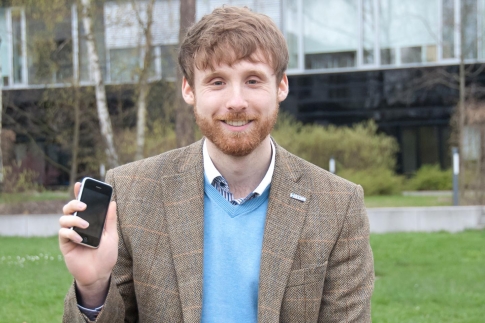Gallium and germanium production could be seven times higher

The global supply potential of the high-tech metals gallium and germanium is much greater than actual annual production levels.
This is the main conclusion from Max Frenzel's work. Frenzel, a postgraduate student at the Helmholtz Institute Freiberg for Resource Technology (HIF), which closely cooperates with the TU Bergakademie Freiberg, is one of two recipients of the Bernd Rendel Prize for Geosciences 2016.
The prize, awarded by the German Research Foundation (DFG), will be presented on 28th September at the annual conference of the German Geological Society (DGGV) in Innsbruck.
The young scientist (27), born in Löbau/Saxony, impressed the DFG Jury not only with his diverse research background, but also with his international experience. Before he came to the HIF he studied Mineral Science and Geological Sciences at the University of Cambridge (2008 to 2012) obtaining first class honors degrees in both subjects.
"In Freiberg, considerable experience is available concerning both mineral economics as well as the formation of mineral deposits; this was my reason for coming here in 2012", said Frenzel. Since then he has worked on the global availability of critical metals and their economic exploitation.
Gallium is essential for the production of high-performance chips used in smartphones and tablets, while germanium is required, for instance, for the production of fibre optic cables.
According to Frenzel's estimate, based on comprehensive calculations, the annual global production of gallium and germanium could be at least seven times higher than it is at present. He said: "At least 2,900 tonnes of gallium could be produced every year, while current (2014) production is 440 tonnes. For germanium, current (2014) production is 165 tonnes, while it could be at least 1,200 tonnes."
He explained, "Previously, the exact quantities of high-tech metals available to industry was not known"; giving this as the motivation for his research. Due to their low concentrations in primary ores, raw materials such as gallium and germanium are predominantly won as by-products from the mining of other quantitatively more important main products; whereas gallium is found in aluminium and zinc ores, germanium is obtained during the production of zinc and coal. Consequently, the availability of both of these elements is mainly constrained by geological factors. However, technological and economic factors also play their part.
Supply risk for critical metals unknown
At present, geoscientists assume that the availability of high-tech metals in the ground is high enough to cover demand. "None of them can be seen as critical in geological terms," said Jens Gutzmer, a mineral deposits expert at the TU Bergakademie Freiberg and director at the Helmholtz Institute Freiberg for Resource Technology. Gutzmer has advised and mentored Max Frenzel during his post-graduate studies, in which Frenzel developed the new raw material estimation method as part of his dissertation.
Gallium and germanium are the first two high-tech metals whose availability Frenzel has examined using his new method. Very probably, the available amounts of both these metals will be sufficient to cover future demand. "However, the new estimation method might reveal potential supply risks for other metals", said Gutzmer.
New type of estimation method for by-products
To be able to forecast the global availability of mineral raw materials with greater accuracy, Frenzel determines the probable range of the supply potentials of a particular by-product, taking into account the effects of different recovery processes for the metals as well as various other factors. He estimates that, with a probability of 95 percent, the supply potential of gallium lies between 2,900 and 10,400 tonnes per annum, and that of germanium between 1,200 and 4,300 tonnes. In both cases, the probable range is between seven and 25 times the amount of current annual production. The estimates are dependent on the further mining of the main products in which gallium (aluminium and zinc ores) and germanium (zinc ore and coal) are found.
Bernd Rendel Prize 2016
Since 2002, the DFG has been awarding this prize to young graduate geoscientists who have not yet obtained their doctorate. The prize money of €1,500 is intended to be used for scientific purposes. "I will probably use it to attend the Goldschmidt 2017 geochemistry conference in Paris to present my findings there," said Frenzel. Next year, he will continue his research at the University of Adelaide in Australia, for which he has received a one and a half year scholarship from the German Academic Exchange Service (DAAD).


































